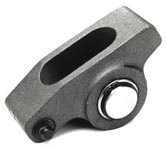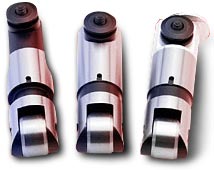|
Hydraulic Roller Cams
By Jeff Burk
4/7/03

There's an old joke in the pits that goes something
like "How do you know when a motor is in a bracket
racer's car? If the valve cover nuts are rusted
and the valve cover is dusty."
The point of the joke is that bracket racers
simply don't have time to do a lot of maintenance
between rounds. Cooling the engine and trans,
refueling and perhaps a few adjustments to the
throttle stop and delay box are about all they
have time for, especially if it is a six, seven
or even eight round affair. They especially
don't want to be forced to take the valve covers
off and adjust the valve lash or check springs
or any of those things that Pro and some class
racers have to do as a matter of course.
So, both weekend warriors and professional
bracket racers are buying engines built to deliver
the power they need without being run on the
ragged edge every pass. They generally are buying
500-600 inch engines that make power at 8,000
rpm or less and require freshening once a year
at most.
 In
order to deliver that kind of power and performance,
engine builders have had to develop engines
that deliver the torque and horsepower the racers
want and yet are reliable. In
order to deliver that kind of power and performance,
engine builders have had to develop engines
that deliver the torque and horsepower the racers
want and yet are reliable.
 One
area in the engine that has been the subject
of much R&D in an effort to deliver parts that
are "bulletproof" is the valvetrain. Roller
cams, lifters, rocker arms and high pressure
springs have long been the choice of engine
builders when it comes to building engines that
are both reliable and powerful. Builders know
that in order to make power at higher rpm ranges
or with smaller motors, the use of mechanical
"roller" camshafts, lifters and springs has
been required. Those pieces, however, are expensive
to buy and replace, and re quire regular maintenance
by the racer. One
area in the engine that has been the subject
of much R&D in an effort to deliver parts that
are "bulletproof" is the valvetrain. Roller
cams, lifters, rocker arms and high pressure
springs have long been the choice of engine
builders when it comes to building engines that
are both reliable and powerful. Builders know
that in order to make power at higher rpm ranges
or with smaller motors, the use of mechanical
"roller" camshafts, lifters and springs has
been required. Those pieces, however, are expensive
to buy and replace, and re quire regular maintenance
by the racer.
DEFINITIONS

Just what is a "roller" camshaft and why is
it a desirable item to have in a high performance
engine? The term roller actually doesn't apply
to the camshaft itself but rather to the lifters
and the rocker arms. A "flat tappet" camshaft's
lifter is a solid cylinder of metal that sits
directly on the surface of the cam lobe and
actuates the push rod and the rocker arm. A
solid or hydraulic lifter combined with a standard
no-roller rocker arm create more heat and drag
in the engine because of friction.
NEXT
PAGE >>
|